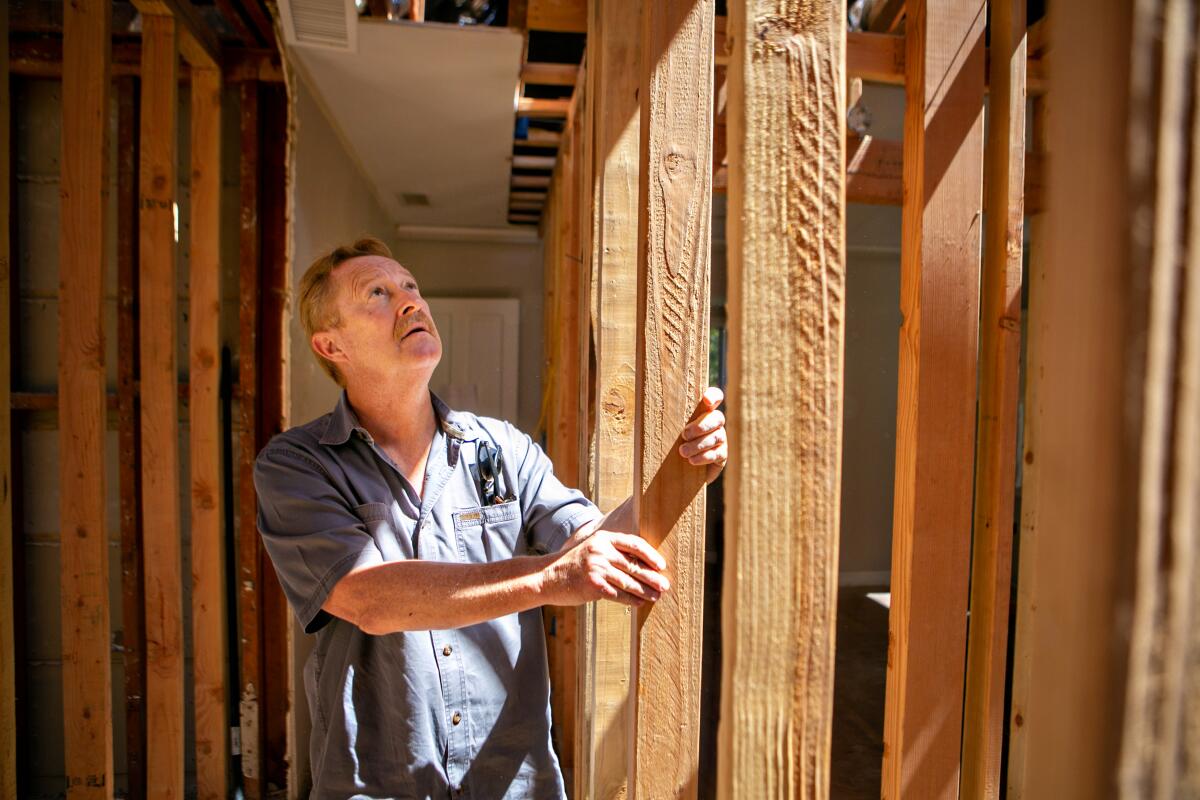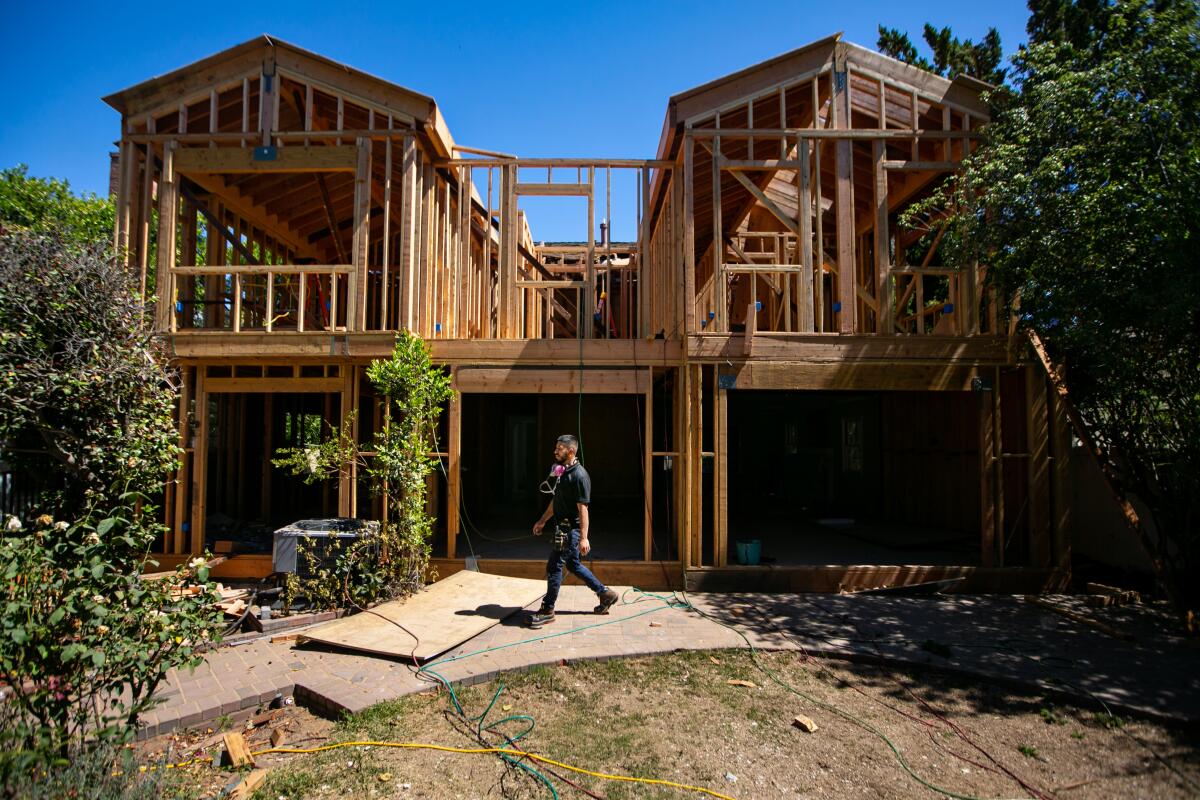Lumber is wildly expensive now. Even picnic table prices are through the roof

- Share via
The cost of a common commodity has scrambled summer plans, and it’s not gas: Soaring lumber prices are making new homes, renovations and even simple picnic tables drastically more expensive.
At times, bills are coming in thousands or even hundreds of thousands of dollars over estimate. In the most extreme cases, projects have come to a screeching halt as prices spiral out of control.
Ken Kahan, president of developer California Landmark Group, said he paused work on a 50-plus unit apartment project in the Los Angeles area after a lumber bid came in triple the original projection. “When you look at commodities do that — either the world is turning upside down or there is just a gyration that just needs to settle down.”
Kahan hopes to restart the project in coming months if lumber prices stabilize, but analysts said pricing is likely to remain elevated for a prolonged period because of the COVID-19 pandemic. When the coronavirus started to spread in the U.S. last year, lumber suppliers assumed demand would plunge, and they stalled production accordingly. Distributors followed this lead, stopped buying lumber and sold off inventories.

But the companies predicted wrong. Many Americans, stuck spending more time at home, decided they wanted a change and sought to remodel. Others sought out a newly built home, including well-off renters who wanted more space and a yard. Those kinds of construction require a lot of lumber.
Homes are flying off the market at a record pace thanks to a perfect storm: pandemic-induced demand for more space, low supply, and apps that make it easier to view, bid for and buy houses — all with a few swipes and clicks.
Suppliers and distributors can’t immediately reverse the effects of their decisions because there aren’t enough skilled workers or active mills to process the wood. “It was just this mad catch-up to ramp everything back up, but it just doesn’t work that way,” said Greg Kuta, chief executive of Westline Capital Strategies, which specializes in lumber trading.
In early May, lumber futures peaked, up more than 300% from a year earlier. Prices have since come down somewhat, but they’re still up more than 200% compared with this time last year.
The inflated prices may last awhile. “I don’t think that you’re going to see this level out for probably 12 to 18 months,” said Tony Uphoff, chief executive of Thomas, a sourcing platform that connects companies with industrial suppliers.

Part of the problem is that the U.S. relies on lumber from Canadian forests — a supply that has shrunk in recent years, Uphoff said. In 2017, the Trump administration imposed a 24% tax on softwood lumber imported from Canada, and in response, several Canadian mills shut down. “That actually was the initial step that created some of the problems we’re still seeing in the supply chain today,” Uphoff said.
Despite the constraints, construction of new homes is still on the rise this year, reflective of hot housing demand that developers say they are rushing to meet.
Southern California home priced jumped 20.2% year-over-year in April, marking the first leap of more than 20% since December 2013.
But some builders are starting to slow down. If that choice becomes widespread, it could exacerbate a supply shortage that’s been driving up housing costs for years. Some are pressing pause on existing projects, while others say it’s harder to find new deals that still work financially given the rise in lumber prices.
For some companies, the big issue isn’t even price, but rather whether they can find supplies, whether it’s wood or other staples made scarcer by pandemic-ravaged supply chains.
Shay BenZvi, a contractor and owner of Green Remodeling Solutions in Canoga Park, said he sometimes walks into the store only to find two-by-fours that are warped and ruined.
“A lot of the companies took out their bad stock ... and they put it out there on the shelves so people will have lumber,” he said. “But this is not something that can work.”
Even smaller projects are affected. JeanPierre Nalbantian has built and operated a haunted house in Burbank every October for the last seven years. But this year, he’s not sure what he’ll be able to afford.
After visiting Lowe’s and seeing lumber prices double or triple compared with previous years, Nalbantian has started looking on Craigslist. He also turned to Twitter, asking for leads to cheaper materials. “I do drive around and try to find free lumber laying around,” he said. So far, he has bought two sheets of plywood.
Now he’s figuring out what he can accomplish within budget this year. “Right now I’m just waiting for the prices to drop,” he said.
At the Black Cat restaurant in Silver Lake, manager Benjamin Schwartz struggled to track down affordable picnic tables for the outdoor dining section. When he called home improvement stores such as Lowe’s and looked online, he often found the wooden tables at double or triple the price he’d expected.
Finally, he found something in the normal range.
“We have some picnic benches that we bought for $100 each that were really hard to come by,” Schwartz said.
Among those pausing projects are affordable-housing developers who have to cobble together financing from myriad sources that enable them to subsidize rents.
“We are getting to a point where we have to slow down our pipeline,” said Jesús Hernández, director of housing development at Community Corp. of Santa Monica, a nonprofit builder. Continuing at the former pace, he said, would cut too deeply into the group’s funds and prevent it from putting together future projects.
Rapidly rising home prices, on the other hand, give developers of single-family homes more of a chance to keep building, and some developers said they’ve been able to pass along price increases.
In March, slightly more than half of homes sold for over the asking price across Los Angeles. In some spots, the share was even bigger.
According to the National Assn. of Home Builders, rising lumber costs are adding nearly $36,000 to the cost of an average newly built house and some developers are getting creative at passing that along.
When buying a newly built home, buyers before the pandemic typically signed up for a waiting list and then paid a set price for a builder to construct the house on a vacant lot in a new-home community. But an April survey from the trade group found a majority of builders now have “escalation” contracts that allow them — if construction costs rise — to increase the sales price after a buyer makes a down payment.
Doug Bauer, chief executive of national home builder Tri Pointe Homes, said that despite the price increases, he isn’t seeing buyer fatigue and noted that his company could sell homes faster.
Rather than escalation clauses, he said Tri Pointe has decided to slow the number of lots it releases to homeowners for sale. He said that enables Tri Pointe to price the homes at a point that better covers surging lumber costs. It’s a go-slow strategy more and more builders report employing.
Contractor Chris Williams said he’s consistently raised the price he charges to build backyard homes known as ADUs, an increasingly popular investment for homeowners after the state loosened development restrictions in recent years in a bid to ease the housing shortage. So far Williams said people are paying, but lumber prices sometimes move fast and don’t enable him to cover his costs.
Over the past four years, lawmakers have quietly chipped away at zoning communities for single-family homes only, opening the door to smaller backyard units.
“Once I sign that contract for that amount of money, say $300,000 or whatever it is, I have to stick to that,” he said. “I just got to take a hit and then on the next project put my prices up to adjust.”
Mike Moore, co-owner of Snap ADU in Oceanside, said he’s had to raise prices by about 30% on the ADUs his company builds, with a common 500-square-foot one-bedroom model rising from $125,000 to about $170,000.
In addition to the lumber issue, he said the costs of metal, windows and appliances are on the rise as well: “Almost on a weekly basis our supply houses and vendors are emailing us saying, ‘I’m so sorry, more price increases are coming.’”
More to Read
Inside the business of entertainment
The Wide Shot brings you news, analysis and insights on everything from streaming wars to production — and what it all means for the future.
You may occasionally receive promotional content from the Los Angeles Times.
















